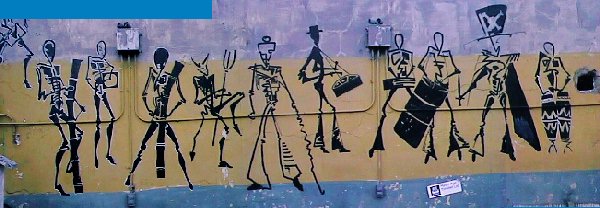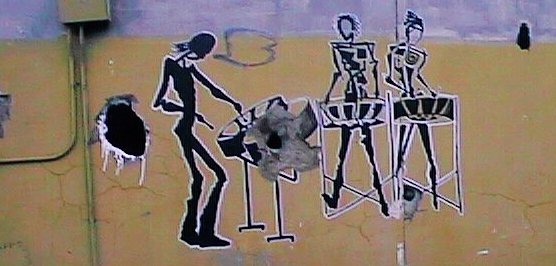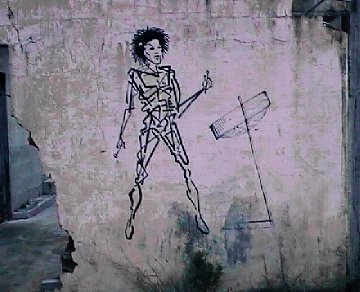THE DANCING WALLS
San Fernando - Trinidad
|
From: The Living Islands Project THE DANCING WALLS San Fernando - Trinidad |
|
Back to Skiffle Bunch
Start - Character Index - End
Dancing Wall 1 - Dancing Wall 2 - Lone Player
The Skiffle Bunch panyard wall paintings.
Artist: Glen Steel
Going round 'The Hill' on 'The Coffee' towards San Fernando, on the right, just before turning down Cipero Street, is the panyard of The Skiffle Bunch steelband. The panyard lot begins with a small empty rough space, often used as a car park.
A narrow decaying building that houses the pans comes next; where its back parts spill over to make smaller this previous space.
And finally, the big open yard, twice as wide as the rest with its bunting and strings of lights, is more tidily level and 'pitched' and doubles as the parking lot for The Southern Food Basket grocery across the road.At off-session times, to keep the grocer happy, much of the iron-mongery that makes up the wheeled trestles on which the steelbands instruments are hung, are moved from the 'big' practice yard and crowded onto the lesser parking lot.
Finishing of the remaining back space of the lesser lot, is a dented rusting half-container that houses and protects the smaller tenor, cello and guitar pans, and other little things of the band.From this small lot can be seen, in as much disdain as the building on which it decorates presents its neglect to the paraphernalia the tends to obscure it, the astonishing fading frescos of The Dancing Walls.
For want of a better name or until I have learnt more; I call the long painting on the main building The Dancing Wall; and the back wall painting The Lone Player.The images, bare to the elements and painted in 1994 by a local artist Glen Steel, capture and trace in remarkable dynamics 50 years of the story of the history of the steelband interwoven with historic characters of carnival.
According to Junia Regrello, the captain of The Skiffle Bunch steelband, Glen Steel was asked to depict the history of The Skiffle Bunch on the panyard walls.
The Skiffle Bunch, whose true origins are still under investigation, began their existence somewhere in the early 1970's, according to fragmentary reports presently at hand. They are a descendant and splinter group of the old and once famous southern steelband Sundowners.
The Skiffle Bunch, who started as a Traditional or 'Pan round the neck' band, after virtually defining the genre with still unparalleled success in that category, changed their status to that of a Conventional steelband some time in 1993. In 1994 they attained moderate success at Panorama, and it was around this time that the Dancing Walls were commissioned; although commissioned may not quite be the right word for it.The expressive result was more universal. See for yourself.
Back to Skiffle Bunch
Start - Character Index - End
Dancing Wall 1 - Dancing Wall 2 - Lone Player

Back to Skiffle Bunch
Start - Character Index - End
Dancing Wall 1 - Dancing Wall 2 - Lone Player

Back to Skiffle Bunch
Start - Character Index - End
Dancing Wall 1 - Dancing Wall 2 - Lone Player
A complete mosaic of the Dancing Wall may be found through this Next Page link.

| The Dancing Seasons | Start - Character Index - End Dancing Wall 1 - Dancing Wall 2 - Lone Player |
JAB MOLASS - Back
John Mendes © 1986 Cote ce Cote la: Pg 179
French diable - devil. Molasses devil - because they smeared their skin with molasses. [Today they sometimes use car grease]. Their chains were clearly related to slavery. They blow whistles and beat large tins [square cooking oil or biscuit pans] that are tied [around the back of their] necks, in a brisk, rhythmic tempo.
TAMBOO BAMBOO - Back
The tamboo bamboo players pounding their long jointed 'bass' or 'boom' bamboo on the ground. Components of the percussive ensembles that pre-dated the steelbands and were popular up to the early 1940's. Some smaller ensembles still exist today to demonstrate the old traditions.STOKER of FIREMAN - Back
John Mendes © 1986 Cote ce Cote la: Pg 178
[Component of the ever popular earlier sailor mas' bands.] Stokers dressed in merinos wearing thick gloves and heavy goggles, pushing before them long iron rods. [Relating to stoking the early steam ships.] The Fireman Dance is performed on the streets. They shuffled forward, bent low at the knees, with shoulders held back; while making suggestive movements with the long iron rods.
PING PONG and TENOR player - Back
An early steelbandsman playing the ping pong - which later became [in Trinidad] the tenor pan- 1939 -1946. Part of the traditional 'Pan round the neck' ensemble.SAILOR BANDS - Back
John Mendes © 1986 Cote ce Cote la: Pg 185
One of the most popular portrayals in [particularly earlier] carnival. The costume is inexpensive and light and allows freedom of movement. Sailors may very from simple outfits to the richly costumed King Sailor. [The depicted pirate would be a variant on this theme] The long nose face mask developed into large headpieces depicting birds, fishes, flowers, animals and a verity of objects. Dress is decorated with medallions etc. [And carry military adornment]
DU DUP or BASS player - Back
Again part of the traditional 'Pan round the neck' ensemble, the Du Dup or Bass steel drummer.The CONGA player - Back
The congas or tumbas forming part of the drum rhythms. The depiction here leans more towards the conventional band structure than the traditional steelband, although the drums were/are, in singular use, part of the traditional steelbands instruments. The timeline moves forward.The TENOR player(s) - Back
Male and female tenor players with mounted single tenor pans as components of the conventional steelband.The DOUBLE-TENOR player - Back
Mounted double-tenor - or could be guitar pans or whatever double pans - pans as components of the conventional steelband.The LONE Player - Back
Each to their own interpretation. [The pan instrument appears to have been added later, although I could be wrong, because it appears too linear for the artist's style - will investigate this.]There is nothing that can be added here other than my own very personal comment. This image, the whole together with the picture it contains, is particularly endearing to me. I tried to extract the picture only, but it did not seem right - all by itself; so I left in all the craggy background as well. This is good. This image represents a curious Trinidad and Tobago to me. The crumbling unfinish that is so much part of these islands, this place. The feelings stirred by this image embodies not a degradation to our islands - there are many other beautiful things as yet to be displayed - so much as a reminder of 'the things that need to be done', to pull ourselves forward into our as yet unattained 'brave new world'. The contemplation on the face of the lone pan-player leads to my own interpretation of the 'hope for a better future'; with the 'attainment' dynamically captured by the artist in the stance and trace of the figure. Yes. This is in essence, my own T&T.
A HOLE - Back 1 - Back 2
A hole in the wall.A Hydro Agri Skiffle Bunch Logo - Back 1
A discarded Hydro Agri sticky logo. The bands sponsors name-tag usually stuck on the drums.
Back to Skiffle Bunch
Start - Character Index - End
Dancing Wall 1 - Dancing Wall 2 - Lone Player
Images: Digital CASIO QV-100 © 1998: tobagojo@trinidad.net
| The Living Islands Project © 1998: tobagojo@gmail.com - 980531 Last Update: 02 June 1998 00:00:00 Processed by: Jeremy G de Barry |
|
| http://www.seetobago.org/trinidad/skifwall/skifwal1.htm | © 1997: tobagojo@gmail.com - 19980531 - 1m20071228 - 2m20140615 Historic Update: 02 June 1998; Last Update: 20 June 2014 02:30:00 TT Processed by: Jeremy G de Barry |
|
| An historic web page for this site; one of the first set by The Living Islands Projects. The page is left mostly in its origional presentation format, apart from an external update to its active eMail link; and internal coding and 'METAS' that update its compatability, list its content and records its dating history. This footer is added for update compatibility. | ||